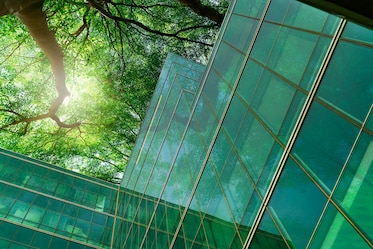What cities are doing to fight climate change
Our urban areas are hubs of heat and increased energy consumption. But efforts are in play all over the world to help us turn down the heat.
Photograph by Fahroni / Shutterstock

Please be respectful of copyright. Unauthorized use is prohibited.
The need to cool down cities
In 1950, 30% of the world’s population lived in cities. That number is skyrocketing, and by 2050, over two-thirds of people across the globe will live in urban areas. Such urbanization has created “urban heat islands” where buildings and roads absorb and re-emit the sun’s heat more than natural landscapes, resulting in temperatures up to 7°F higher than outlying areas and intensifying the effects of climate change, including risks to human health.
Photograph by Sergey Novikov / Shutterstock
Please be respectful of copyright. Unauthorized use is prohibited.
Designing efficient buildings
Cities account for 70% of energy consumption and 40 to 50% of greenhouse gas emissions globally. Much of that comes from buildings, which are responsible for nearly one third of all global energy consumption. But construction of zero-net energy buildings is on the rise. The Pixel building in Melbourne, Australia, that produces all its own energy and water; the Bahrain World Trade Center whose sky bridges hold wind turbines; and The Edge in Amsterdam, a smart building that produces more energy than it consumes, are all innovative examples of buildings combining renewable energy with energy efficiency to consume only as much energy as is generated on site.
Photograph by Dr Ajay Kumar Singh / Shutterstock
Please be respectful of copyright. Unauthorized use is prohibited.
Certifying green offices
Many cities with thriving business districts made up principally of office buildings are acting to reverse consumption. For several years in a row, Chicago has led the United States as the greenest place to work. With 71.1% of all office space certified, it claimed the most energy-efficient office buildings in the country in 2019, leading close competitors San Francisco, Atlanta, and Los Angeles. “Green” buildings must hold an Energy Star label or LEED certification, two of the country’s leading energy efficiency certifications.
Photograph by JaySi, Shutterstock
Please be respectful of copyright. Unauthorized use is prohibited.
Innovating efficient office appliances
Computers and other office equipment account for 14% of energy consumed in commercial buildings (according to the most recent 2012 data). Energy-efficient electronics are playing a key role in the wave of green office spaces in cities, and companies are increasingly innovating energy-efficient appliances to aid in the effort to reduce consumption. Epson, for example, has developed Heat-Free Technology used in their inkjet printers, which draws very little power when printing compared to laser printers.
Photograph by Monkey Business Images / Shutterstock
Please be respectful of copyright. Unauthorized use is prohibited.
Installing cool roofs
Traditional roofs are generally made of dark material and strongly absorb sunlight, heating surrounding air and the building itself to increase energy use for air conditioning. But the surface of a cool roof, made of materials to reflect sunlight and heat away from the building, stays up to 50-60°F cooler in peak summer months. The City of Phoenix—the hottest city in the United States with temperatures forecast to rise in coming years—is actively encouraging the installation of cool roofs as part of its heat mitigation plan.
Photograph by Jinjian Liang / Shutterstock
Please be respectful of copyright. Unauthorized use is prohibited.
Growing living roofs
Made of green vegetation, living roofs mitigate urban heat and other aspects of climate change, like improving food security and biodiversity. Because plants reflect sunlight and release moisture through evapotranspiration to cool the air, surface temperatures of living roofs can be 30-40°F lower during the day that traditional roofs, lowering city-wide temperatures by up to five degrees Fahrenheit and reducing energy use for indoor cooling. Singapore is one of the most well-known leaders in living roof design, creating “cities in a garden” in business centers; and bus lines, hotels, and residential housing with networks of living roofs.
Photograph by Tavarius / Shutterstock
Please be respectful of copyright. Unauthorized use is prohibited.
Laying cool pavement
Traditional pavement can reach a whopping 150°F in summer, and given pavement can cover an average of 30-45% of land in urban areas, it’s a major contributor to rising temperatures and increased indoor cooling. Cool paving materials reflect solar heat, reduce storm-water runoff, and improve water quality. The city of Doha in Qatar is testing a new cool pavement with cryogenic material on popular stretches of road.
Photograph by Benny Marty / Shutterstock
Please be respectful of copyright. Unauthorized use is prohibited.
Planting urban forests
Urban forests—a term encompassing all trees in a city, including on streets, in parks, and on private property—can lower temperatures as well as mitigate climate change by capturing and storing CO2. Seoul is going a step further to intentionally plant wind-path forests along rivers and roads. These are designed to direct clean air from surrounding mountains into the city while lowering the summer temperature in downtown Seoul by nearly 45°F.
Photograph by HAEWON JANG / Shutterstock
Please be respectful of copyright. Unauthorized use is prohibited.
Electrifying roads
Emissions from vehicles crowding urban streets are a major contributor to climate change—transport accounts for 37% of emissions globally—and to the urban heat island effect; electric vehicles emit less than 20% as much heat as gasoline engines. To encourage the mainstream adoption of electric vehicles, Sweden is expanding on its electrified road pilot projects in Stockholm and Lund to create a 13-mile stretch of electrified highway that powers vehicles as they drive.
Learn more about why it's important to turn down the heat.
Learn more about why it's important to turn down the heat.
Photograph by buffaloboy / Shutterstock